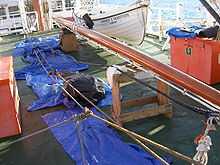Worm, parcel and serve


To worm, parcel and serve a line is to apply a multi-layered protection against chafe and deterioration. It is a technique not usually used on modern small boats, but is found extensively on traditionally-rigged sailing ships. Worming, parcelling and serving is traditionally applied only to traditional twisted rope, not the braided line almost exclusively used on modern vessels, but some traditional vessels now use modern high modulus braided lines (like Amsteel or AS-90) in place of wire rope (to save weight aloft) and serve the line to maintain the traditional appearance.
Technique
Worming
"Worming" the line is designed to fill in the channels (the cuntlines) between the strands in order to keep water out and to allow tighter wrapping of the next layers by giving the rope a more cylindrical shape. Three lengths of "small stuff" or string are led along the lay of the rope between the strands, following the twist so that they spiral round the main line.
Parcelling
The line is then "parcelled" by wrapping it in a spiral fashion with long overlapping strips of thin canvas. This is wound from bottom to top to prevent water from running in - in the same direction as the worming. The rule is "worm and parcel with the lay; turn and serve the other way".
Serving
The outer layer of protection is formed of twine wrapped as tightly as possible around the line, covering it completely. Following the rhyme above, it should of course run against the lay of the rope; this alternation helps prevent sideways chafe from opening up the protection. A serving mallet can be used to help get the outer twine as tight as possible - despite the name (arising from its shape) the serving mallet is not used to hit anything; it forms a kind of guide and tensioning lever for applying the twine to the rope.
Tar
An optional final stage for the permanent protection of rope is to paint the outer layer of twine with a mixture of tar, varnish and black paint. This needs renewing periodically, and going aloft to paint footropes and stays is one of the regular maintenance tasks on many tall ships.
An alternative opinion from someone who does the job: The tar, or "slush" is a mixture of Stockholm tar, boiled linseed oil, and Japan drier. The term "slush" is also used to describe the grease applied to the masts to lubricate the parrels so that the yards can raise and lower freely.
References
- Chapman, C. Piloting, Seamanship and Small Boat Handling, Hearst Corporation, 1972. ISBN 0-910990-10-7
- http://www.thesquarerigger.com/worm_parcel-and_serve.html